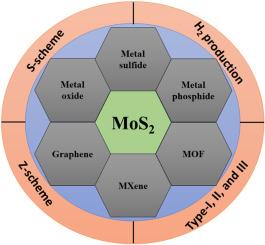基于mos2光催化剂的光催化水裂解制氢研究进展与挑战
IF 7.9
3区 材料科学
Q1 GREEN & SUSTAINABLE SCIENCE & TECHNOLOGY
引用次数: 0
摘要
利用太阳能和适当的光催化剂进行水分解制氢,由于其零排放和成本效益,在过去几十年中被认为是解决全球能源危机的一种优秀的可再生能源技术。二硫化钼是一种极具发展前景的光催化剂,因其低成本、丰度、光电性能而备受关注。尽管具有这些令人着迷的特性,但它在光催化制氢活性方面存在一些缺点,如高载流子复合和基面惰性。在这篇综述中,我们首先确定了MoS2和光催化的性质(光学,电子,晶体结构)的基本知识,更强调光催化制氢比其他制氢方法更可行。随后,对金属/非金属掺杂、异质结的形成和牺牲剂的使用等提高MoS2制氢活性的策略进行了综述。综述了二硫化钼光催化剂与不同助催化剂耦合的光催化制氢性能及其制备方法。本文章由计算机程序翻译,如有差异,请以英文原文为准。

Advances and challenges in MoS2-based photocatalyst for hydrogen production via photocatalytic water splitting
Hydrogen energy production via water splitting by using solar energy and appropriate photocatalyst is considered as an excellent renewable energy technology over the past few decades to address the global energy crisis due to its zero emission and cost effectiveness. MoS2, a family of TMDs, is one of the promising photocatalyst that gained much research attention for its low cost, earth-abundance, optoelectronic properties. Despite these fascinating properties, it suffers some drawbacks in photocatalytic hydrogen production activity such as, high charge carrier recombination and inert basal plane. In this review, we first identify the fundamental knowledge of the properties (optical, electronic, crystal structure) of MoS2 and photocatalysis-with more emphasis on photocatalytic H2 production which was found to be more feasible than other methods of hydrogen generation. Subsequently, various strategies to enhance the MoS2 activity of hydrogen production like metal/non-metal doping, formation of heterojunctions and using sacrificial agents were reviewed. The photocatalytic hydrogen production performance of MoS2 photocatalyst coupled with different cocatalysts and its various methods of preparation were also reviewed.
求助全文
通过发布文献求助,成功后即可免费获取论文全文。
去求助
来源期刊

Materials Today Sustainability
Multiple-
CiteScore
5.80
自引率
6.40%
发文量
174
审稿时长
32 days
期刊介绍:
Materials Today Sustainability is a multi-disciplinary journal covering all aspects of sustainability through materials science.
With a rapidly increasing population with growing demands, materials science has emerged as a critical discipline toward protecting of the environment and ensuring the long term survival of future generations.
 求助内容:
求助内容: 应助结果提醒方式:
应助结果提醒方式:


